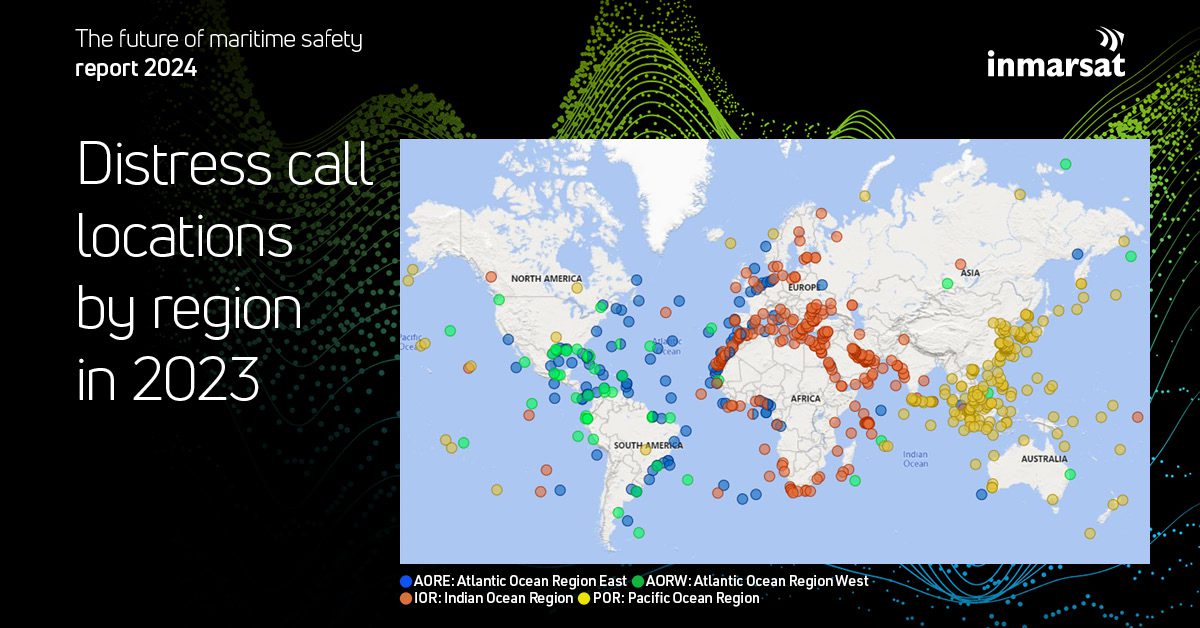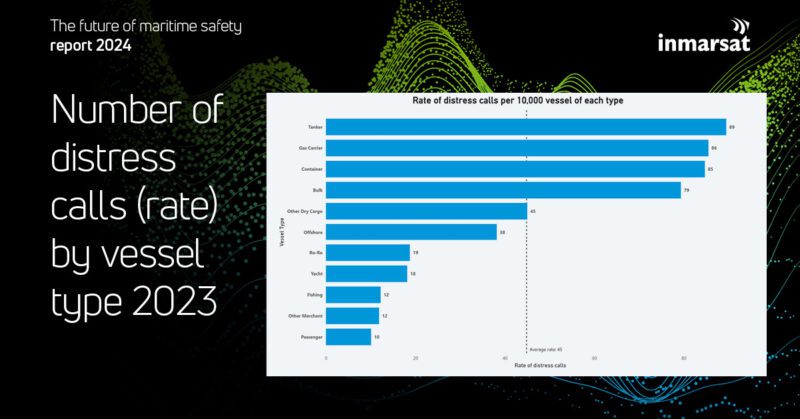ABB to supply integrated power system for nine shuttle tankers
In a major step towards more efficient offshore operations, Samsung Heavy Industries Co., Ltd. (SHI) and ABB have signed an agreement to equip a fleet of shuttle tankers with ABB’s...

By Peter Broadhurst, Senior Vice President, Safety and Regulatory, Inmarsat Maritime

Published by Inmarsat Maritime, a Viasat business, The Future of Maritime Safety Report 2024 provides a snapshot of shipping safety, recovered from Global Maritime Distress and Safety System (GMDSS) calls sent via Inmarsat’s RescueNet and SafetyNet services in 2023. It combines this data with statistics from other sources on casualties and losses to reveal a nuanced and detailed picture of the safety challenges facing our industry.
Demonstrating how anonymised data can help to drive understanding and pinpoint where proactive measures are most needed, the report aims to encourage companies and individuals to share more data to improve situational awareness and facilitate learning. Instead of a blame culture and fear of the perceived negative impacts of openly discussing safety incidents, maritime organisations should embrace collaboration and transparency.
Shipping collects a wealth of safety data, but as an industry, we are not extracting maximum value from this information, as analysis is executed in isolation and findings are not shared among all stakeholders. By pooling data, we can form a more holistic and objective picture of maritime safety to facilitate concrete performance improvements.
While a key first step is for the industry to develop a list of standard data points to monitor and report– including casualties, injuries, and near misses – data is only meaningful if used to inform decision-making. However, with the same factors consistently cited in a significant proportion of maritime incidents, it is clear that lessons are not being learned, and shipping needs more creative solutions.

For example, high-bandwidth connectivity at sea opens the door to more engaging onboard training, which helps to improve operational proficiency and thereby minimise human error. It also supportstelemedicine services, ensuring crew can access medical assistance in an emergency. By keeping seafarers connected with loved ones, onboard Internet access can also minimise feelings of isolation and depression to enhance engagement during tasks.
Alongside better connectivity, crew should get a greater say in the design of ships and onboard equipment. Harnessing seafarers’ unique insight, based on a fundamental shift towards human-centred design principles, can improve ship safety, crew well-being, and operational efficiency while protecting the marine environment.
In addition, open and non-punitive safety cultures would encourage crew to report accidents and near misses more candidly and thoroughly. This data could then be used to inform the procurement of safety equipment and the refinement of onboard procedures. In the context of GMDSS, companies should encourage seafarers to send urgency calls requesting assistance rather than waiting until the vessel is in grave and imminent danger before sending a distress call. Timely action when urgency is required should be critical in a proactive safety culture.
As well as transparency and a willingness to absorb and learn from lessons, embedding a safety culture requires commitment and accountability across all hierarchical levels – from ship owners, operators, and managers to the seafarers on board. Every link in the command chain must invest in prioritising safety and accept an appropriate level of responsibility for their actions. Safety must be seen as a performance indicator of success and not merely another cost driver.
Meanwhile, flag states can use safety data to address known risks proactively and reduce the likelihood of recurring accidents. They can advocate for companies to establish robust preventive maintenance and inspection programmes, using data to inform both, and improve regulatory compliance to help arrest the growing number of port state control detentions.
Governments, for their part, must explore how to reduce the incidence of mis-declared cargo, which can endanger life, property, and the marine environment, and do more to protect seafarers’ rights in line with their status as key workers. In this regard, the significant amendments to the Code of the Maritime Labour Convention 2006 in 2022 are timely. In particular, revised regulations on repatriation, onboard recreational facilities, medical care on board and ashore, health and safety protection, and accident prevention strengthen the rights of seafarers and will, if adhered to, ensure a safer and more equitable working environment.
Responsibility also resides at the inter-governmental level. We are already witnessing a move from prescriptive minimum standards to goal-based standards, such as those adopted for bulk carrier and oil tanker construction, which should drive performance and encourage innovation. However, there is an increasing lag between policy and operational requirements based on new regulations coming into force.
The International Maritime Organization adopted some important safety-related resolutions in 2023 and will continue to do so in the years ahead, but the international regulatory process is now struggling to match the pace of technological change. While shipping has traditionally been seen as a somewhat conservative and slow-evolving industry, it is now changing rapidly, and new threats are arising quickly as a result. Before we can decisively address these threats, we must fully understand them – and to this end, access to reliable anonymised data is critical.

Sign up for gCaptain’s newsletter and never miss an update

Subscribe to gCaptain Daily and stay informed with the latest global maritime and offshore news


Stay informed with the latest maritime and offshore news, delivered daily straight to your inbox
Essential news coupled with the finest maritime content sourced from across the globe.
Sign Up